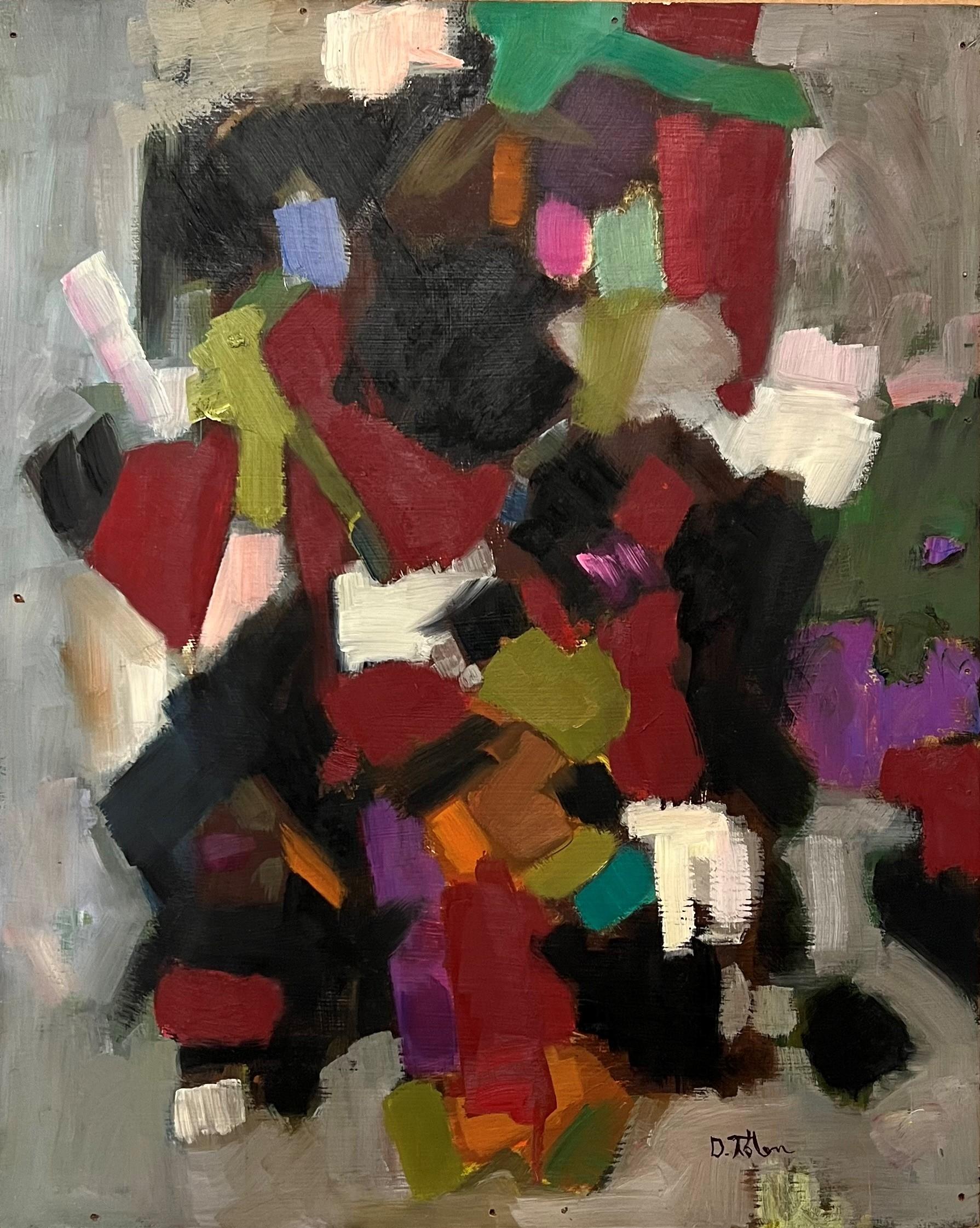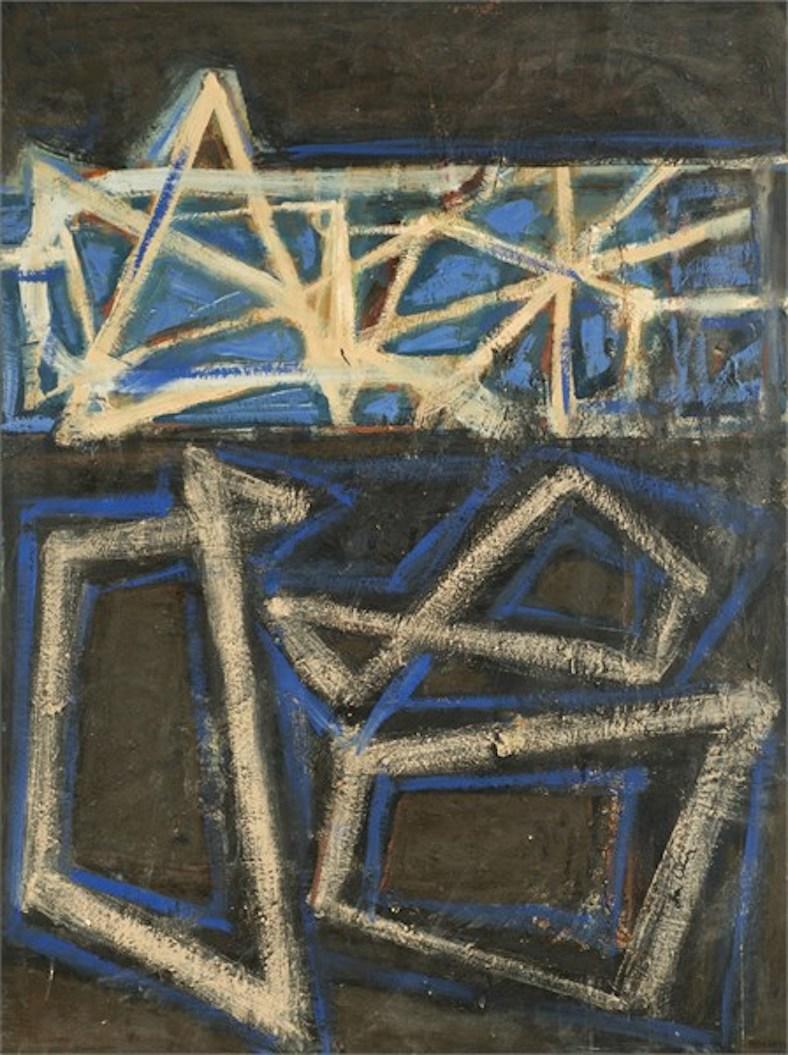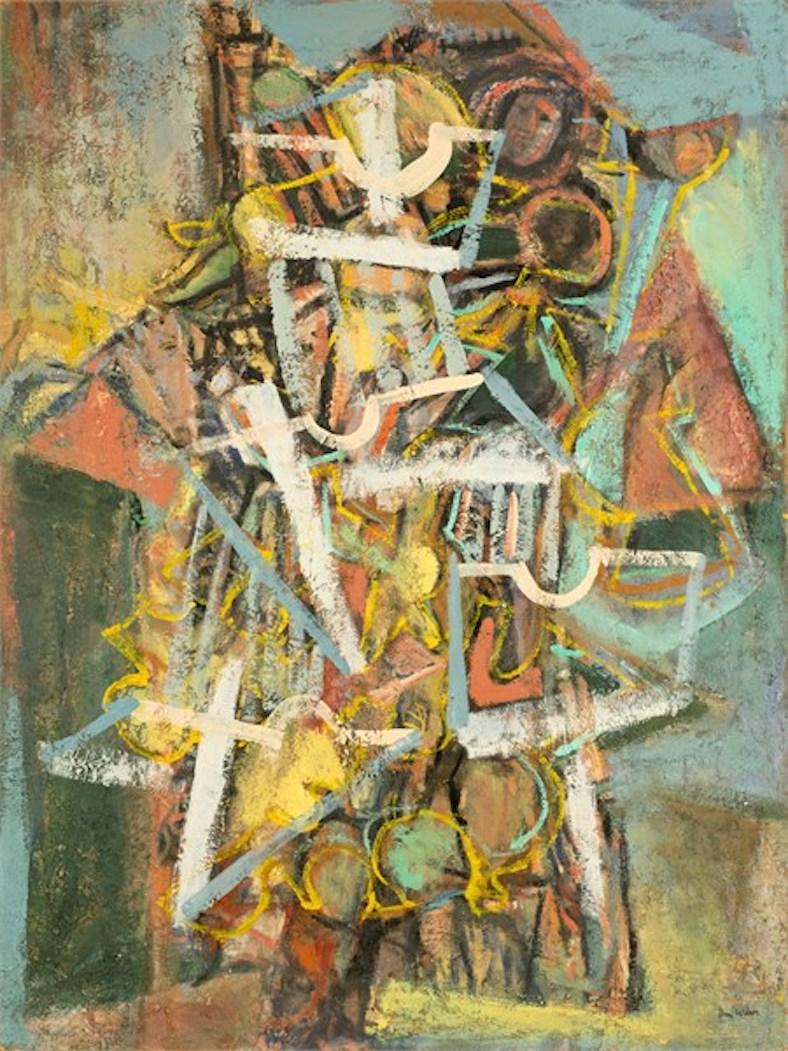Items Similar to Series 67 No.4 abstract oil painting by Jack Wolsky
Want more images or videos?
Request additional images or videos from the seller
1 of 12
Jack WolskySeries 67 No.4 abstract oil painting by Jack Wolsky1955
1955
About the Item
Series 67, No. 4 (1955)
Oil on masonite
48" x 24 ½"
49" x 25 ¼" x 1 ¾" framed
About this artist: Jack Wolsky was born in 1930 in Rochester, New York.
He taught in the Department of Art at SUNY Brockport from 1959 to 1985, where he then became a Professor Emeritus in 1985.
During his time at SUNY Brockport, he was awarded many awards and honors including the Jurors’ Award – Rochester Finger Lakes Show in 1962, the Lillian Fairchild Award in 1970, the Outstanding Educators of America 1971 edition, Who’s Who in American Art 1976 (14th Edition), Chancellor’s Award for Excellence in Teaching in 1979, Rochester Chamber of Commerce Civic Award in Culture and Arts in 1999, Who’s Who in America in 2006, 2007, 2008, 2009, 2010, 2011 and 2012.
He was active in volunteering and being part of several boards. He was an Art Volunteer at the American Red Cross, Rochester Chapter and at the Jewish Home of Rochester. He was a board member for Friends of School of the Arts in Rochester, Temple B’rith Kodesh in Rochester, and the Rochester Area Hillel Foundation.
Jack influenced and shared his knowledge with many young artists. He was loving, kind and humble with an engaging personality, upbeat, friendly and always positive, often funny, and drew everyone to him. He was a real people magnet.
–from the Artist's 2023 Brighton Memorial Chapel obituary
- Creator:Jack Wolsky (1930 - 2023, American)
- Creation Year:1955
- Dimensions:Height: 48 in (121.92 cm)Width: 24.5 in (62.23 cm)
- Medium:
- Movement & Style:
- Period:
- Condition:
- Gallery Location:Hudson, NY
- Reference Number:
About the Seller
5.0
Vetted Seller
These experienced sellers undergo a comprehensive evaluation by our team of in-house experts.
Established in 1973
1stDibs seller since 2023
5 sales on 1stDibs
Typical response time: 1 hour
- ShippingRetrieving quote...Ships From: Hudson, NY
- Return PolicyThis item cannot be returned.
More From This SellerView All
- Untitled 1963 Abstract Oil Painting by Jimmy ErnstBy Jimmy ErnstLocated in Hudson, NYThis abstract is signed and dated "Jimmy Ernst 63" on the lower right. Measurement of artwork is 8 ½" x 8 ¼" and framed measures 15 ½" x 15" x 1 ¼" in a painted frame. Provenance: Gift from the artist to his personal friend architect John Johansen...Category
1960s Abstract Expressionist Abstract Paintings
MaterialsMasonite, Oil
- Inevitable Day – Birth of the Atom oil and tempera painting by Julio De DiegoBy Julio de DiegoLocated in Hudson, NYJulio De Diego’s Atomic Series paintings made an extraordinary statement regarding the shock and fear that accompanied the dawn of the nuclear age. In the artist’s own words, “Scientists were working secretly to develop formidable powers taken from the mysterious depths of the earth - with the power to make the earth useless! Then, the EXPLOSION! . . . we entered the Atomic Age, and from there the neo-Atomic war begins. Explosions fell everywhere and man kept on fighting, discovering he could fight without flesh.” To execute these works, De Diego developed a technique of using tempera underpainting before applying layer upon layer of pigmented oil glazes. The result is paintings with surfaces which were described as “bonelike” in quality. The forms seem to float freely, creating a three-dimensional visual effect. In the 1954 book The Modern Renaissance in American Art, author Ralph Pearson summarizes the series as “a fantastic interpretation of a weighty theme. Perhaps it is well to let fantasy and irony appear to lighten the devastating impact. By inverse action, they may in fact increase its weight.” Bibliography Art in America, April 1951, p.78 About this artists: Julio De Diego crafted a formidable persona within the artistic developments and political struggles of his time. The artist characterized his own work as “lyrical,” explaining, “through the years, the surrealists, the social-conscious painters and the others tried to adopt me, but I went my own way, good, bad or indifferent.” [1] His independence manifested early in life when de Diego left his parent’s home in Madrid, Spain, in adolescence following his father’s attempts to curtail his artistic aspirations. At the age of fifteen he held his first exhibition, set up within a gambling casino. He managed to acquire an apprenticeship in a studio producing scenery for Madrid’s operas, but moved from behind the curtains to the stage, trying his hand at acting and performing as an extra in the Ballet Russes’ Petrouchka with Nijinsky. He spent several years in the Spanish army, including a six-month stretch in the Rif War of 1920 in Northern Africa. His artistic career pushed ahead as he set off for Paris and became familiar with modernism’s forays into abstraction, surrealism, and cubism. The artist arrived in the U.S. in 1924 and settled in Chicago two years later. He established himself with a commission for the decoration of two chapels in St. Gregory’s Church. He also worked in fashion illustration, designed magazine covers and developed a popular laundry bag for the Hotel Sherman. De Diego began exhibiting through the Art Institute of Chicago in 1929, and participated in the annual Chicago Artists Exhibitions, Annual American Exhibitions, and International Water Color Exhibitions. He held a solo exhibition at the Art Institute of Chicago in the summer of 1935. Though the artist’s career was advancing, his family life had deteriorated. In 1932 his first marriage dissolved, and the couple’s young daughter Kiriki was sent to live with friend Paul Hoffman. De Diego continued to develop his artistic vocabulary with a growing interest in Mexican art. He traveled throughout the country acquainting himself with the works of muralists such as Carlos Merida, and also began a collection of small native artifacts...Category
1940s American Modern Abstract Paintings
MaterialsMasonite, Oil, Tempera
- St. Atomic oil and tempera painting by Julio de DiegoBy Julio de DiegoLocated in Hudson, NYJulio De Diego’s Atomic Series paintings made an extraordinary statement regarding the shock and fear that accompanied the dawn of the nuclear age. In the artist’s own words, “Scientists were working secretly to develop formidable powers taken from the mysterious depths of the earth - with the power to make the earth useless! Then, the EXPLOSION! . . . we entered the Atomic Age, and from there the neo-Atomic war begins. Explosions fell everywhere and man kept on fighting, discovering he could fight without flesh.” To execute these works, De Diego developed a technique of using tempera underpainting before applying layer upon layer of pigmented oil glazes. The result is paintings with surfaces which were described as “bonelike” in quality. The forms seem to float freely, creating a three-dimensional visual effect. In the 1954 book The Modern Renaissance in American Art, author Ralph Pearson summarizes the series as “a fantastic interpretation of a weighty theme. Perhaps it is well to let fantasy and irony appear to lighten the devastating impact. By inverse action, they may in fact increase its weight.” Exhibited 1950 University of Illinois at Urbana "Contemporary American Painting" 1964 Marion Koogler McNay Art Institute, San Antonio, Texas This work retains its original frame which measures 54" x 36" x 2". About this artist: Julio De Diego crafted a formidable persona within the artistic developments and political struggles of his time. The artist characterized his own work as “lyrical,” explaining, “through the years, the surrealists, the social-conscious painters and the others tried to adopt me, but I went my own way, good, bad or indifferent.” [1] His independence manifested early in life when de Diego left his parent’s home in Madrid, Spain, in adolescence following his father’s attempts to curtail his artistic aspirations. At the age of fifteen he held his first exhibition, set up within a gambling casino. He managed to acquire an apprenticeship in a studio producing scenery for Madrid’s operas, but moved from behind the curtains to the stage, trying his hand at acting and performing as an extra in the Ballet Russes’ Petrouchka with Nijinsky. He spent several years in the Spanish army, including a six-month stretch in the Rif War of 1920 in Northern Africa. His artistic career pushed ahead as he set off for Paris and became familiar with modernism’s forays into abstraction, surrealism, and cubism. The artist arrived in the U.S. in 1924 and settled in Chicago two years later. He established himself with a commission for the decoration of two chapels in St. Gregory’s Church. He also worked in fashion illustration, designed magazine covers and developed a popular laundry bag for the Hotel Sherman. De Diego began exhibiting through the Art Institute of Chicago in 1929, and participated in the annual Chicago Artists Exhibitions, Annual American Exhibitions, and International Water Color Exhibitions. He held a solo exhibition at the Art Institute of Chicago in the summer of 1935. Though the artist’s career was advancing, his family life had deteriorated. In 1932 his first marriage dissolved, and the couple’s young daughter Kiriki was sent to live with friend Paul Hoffman. De Diego continued to develop his artistic vocabulary with a growing interest in Mexican art. He traveled throughout the country acquainting himself with the works of muralists such as Carlos Merida, and also began a collection of small native artifacts...Category
1940s American Modern Abstract Paintings
MaterialsMasonite, Oil, Tempera
- The Magician oil and tempera painting by Julio de DiegoBy Julio de DiegoLocated in Hudson, NYJulio De Diego’s Atomic Series paintings made an extraordinary statement regarding the shock and fear that accompanied the dawn of the nuclear age. In the artist’s own words, “Scientists were working secretly to develop formidable powers taken from the mysterious depths of the earth - with the power to make the earth useless! Then, the EXPLOSION! . . . we entered the Atomic Age, and from there the neo-Atomic war begins. Explosions fell everywhere and man kept on fighting, discovering he could fight without flesh.” To execute these works, De Diego developed a technique of using tempera underpainting before applying layer upon layer of pigmented oil glazes. The result is paintings with surfaces which were described as “bonelike” in quality. The forms seem to float freely, creating a three-dimensional visual effect. In the 1954 book The Modern Renaissance in American Art, author Ralph Pearson summarizes the series as “a fantastic interpretation of a weighty theme. Perhaps it is well to let fantasy and irony appear to lighten the devastating impact. By inverse action, they may in fact increase its weight.” Exhibited 1964 Marion Koogler McNay Art Institute, San Antonio, Texas This work retains its original frame which measures 54" x 42" x 2" About this artist: Julio De Diego crafted a formidable persona within the artistic developments and political struggles of his time. The artist characterized his own work as “lyrical,” explaining, “through the years, the surrealists, the social-conscious painters and the others tried to adopt me, but I went my own way, good, bad or indifferent.” [1] His independence manifested early in life when de Diego left his parent’s home in Madrid, Spain, in adolescence following his father’s attempts to curtail his artistic aspirations. At the age of fifteen he held his first exhibition, set up within a gambling casino. He managed to acquire an apprenticeship in a studio producing scenery for Madrid’s operas, but moved from behind the curtains to the stage, trying his hand at acting and performing as an extra in the Ballet Russes’ Petrouchka with Nijinsky. He spent several years in the Spanish army, including a six-month stretch in the Rif War of 1920 in Northern Africa. His artistic career pushed ahead as he set off for Paris and became familiar with modernism’s forays into abstraction, surrealism, and cubism. The artist arrived in the U.S. in 1924 and settled in Chicago two years later. He established himself with a commission for the decoration of two chapels in St. Gregory’s Church. He also worked in fashion illustration, designed magazine covers and developed a popular laundry bag for the Hotel Sherman. De Diego began exhibiting through the Art Institute of Chicago in 1929, and participated in the annual Chicago Artists Exhibitions, Annual American Exhibitions, and International Water Color Exhibitions. He held a solo exhibition at the Art Institute of Chicago in the summer of 1935. Though the artist’s career was advancing, his family life had deteriorated. In 1932 his first marriage dissolved, and the couple’s young daughter Kiriki was sent to live with friend Paul Hoffman. De Diego continued to develop his artistic vocabulary with a growing interest in Mexican art. He traveled throughout the country acquainting himself with the works of muralists such as Carlos Merida, and also began a collection of small native artifacts...Category
1940s American Modern Abstract Paintings
MaterialsMasonite, Oil, Tempera
- Ceremonial Dancers oil and tempera painting by Julio De DiegoBy Julio de DiegoLocated in Hudson, NYArtwork measures 48" x 30" and framed 56 ¼" x 38 ¼" x 3" Provenance: John Heller Gallery, NYC, circa 1975 (label verso) The artist's daughter Corbino Galleries, Sarasota, FL (1990)...Category
1940s Modern Abstract Paintings
MaterialsMasonite, Oil, Tempera
- Environs of a Bridge oil painting by Seymour FranksBy Seymour FranksLocated in Hudson, NYHand-signed and dated "Franks 44" lower right. This work is in its original hand painted frame, made by the artist. The frame measures 29 ½" x 35 ½" x 1 ¾" and the canvas measures 26...Category
1940s Abstract Expressionist Abstract Paintings
MaterialsCanvas, Oil
You May Also Like
- UntitledLocated in Irvine, CA"Untitled" by Don Totten is an abstract oil painting on masonite circa 1960 and measures 20 in x 16 in. The painting is in good condition. Donald C. Totten (1903-1964) was a member...Category
1960s Abstract Abstract Paintings
MaterialsMasonite, Oil
- UntitledLocated in Irvine, CA"Untitled" by Don Totten is an abstract oil painting circa 1960 on canvas and measures 16 in x 20 in. It is in excellent condition. Donald C. Totten (1903...Category
1960s Abstract Abstract Paintings
MaterialsMasonite, Oil
- Emerging Entity, c. 1985By Ben WilsonLocated in Quogue, NYBorn in Philadelphia, Ben Wilson was a New York abstract expressionist painter. His work was exhibited frequently from the mid-thirties through sixties, and less frequently but consi...Category
1980s Abstract Abstract Paintings
MaterialsMasonite, Oil
- Chartres, 1989By Ben WilsonLocated in Quogue, NYBorn in Philadelphia, Ben Wilson was a New York abstract expressionist painter. His work was exhibited frequently from the mid-thirties through sixties, and less frequently but consi...Category
1980s Abstract Expressionist Abstract Paintings
MaterialsMasonite, Oil
- Gibraltar, 1963By Ben WilsonLocated in Quogue, NYBorn in Philadelphia, Ben Wilson was a New York abstract expressionist painter. His work was exhibited frequently from the mid-thirties through sixties, and less frequently but consi...Category
1960s Abstract Abstract Paintings
MaterialsMasonite, Oil
- Untitled, 55By Ben WilsonLocated in Quogue, NYBorn in Philadelphia, Ben Wilson was a New York abstract expressionist painter. His work was exhibited frequently from the mid-thirties through sixties, and less frequently but consi...Category
1960s Abstract Expressionist Abstract Paintings
MaterialsMasonite, Oil





